Evanescent Wave Fiber Optic Biosensor for Salmonella Detection in Food
Abstract
:1. Introduction
2. Results and Discussion
2.1. Reaction Characteristics of Anti-Salmonella PAb and Anti-Salmonella MAb 2F-11 by ELISA
2.2. Sensitivity and Specificity of Fiber-Optic Biosensor
2.3. Sensitivity and Specificity of Time-Resolved Immunofluorescence (TRF) Assay
2.4. Detection of S. Enteritidis Grown in Shell Egg and chicken Breast Using Fiber Optic and TRF Assay
2.4.1. Fiber-optic assay
2.4.2. TRF assay
3. Experimental Section
3.1. Cultures and Media
3.2. Antibodies and Labeling
3.3. Fiber Preparation, Blocking and Background Reading
3.4. Fiber-optic Assays
3.5. Sensitivity and Selectivity of Fiber-Optic Sensor
3.6. TRF Assays
3.7. Detection of S. Enteritidis from Artificially Inoculated Shell Eggs and Chicken Breast
3.8. Statistical Analysis
4. Conclusions
Acknowledgments
References and Notes
- DuPont, H.L. Food safety: the growing threat of foodborne bacterial enteropathogens of animal origin. Clin. Infect. Dis 2007, 45, 1353–1361. [Google Scholar]
- Isaacs, S.; Aramini, J.; Ciebin, B.; Farrar, J.A.; Ahmed, R.; Middleton, D.; Chandran, A.U.; Harris, L.J.; Howes, M.; Chan, E.; Pichette, A.S.; Campbell, K.; Gupta, A.; Lior, L.Y.; Pearce, M.; Clark, C.; Rodgers, F.; Jamieson, F.; Brophy, I.; Ellis, A. An international outbreak of salmonellosis associated with raw almonds contaminated with a rare phage type of Salmonella enteritidis. J. Food Prot 2005, 68, 191–198. [Google Scholar]
- Centers for Disese and Prevention. Multistate outbreak of Salmonella infections associated with peanut butter and peanut butter-containing products - United States, 2008–2009. MMWR 2009, 58, 85–90. [Google Scholar]
- Humphrey, T. Science and society - Salmonella, stress responses and food safety. Nat. Rev. Microbiol 2004, 2, 504–509. [Google Scholar]
- Santos, R.L.; Tsolis, R.M.; Baumler, A.J.; Adams, L.G. Pathogenesis of Salmonella-induced enteritis. Brazilian J. Med. Biol. Res 2003, 36, 3–12. [Google Scholar]
- Altekruse, S.F.; Bauer, N.; Chanlongbutra, A.; DeSagun, R.; Naugle, A.; Schlosser, W.; Umholtz, R.; White, P. Salmonella Enteritidis in broiler chickens, United States, 2000–2005. Emerg. Infect. Dis 2006, 12, 1848–1852. [Google Scholar]
- Swaminathan, B.; Barrett, T.J.; Fields, P. Surveillance for human Salmonella infections in the United States. J. AOAC Int 2006, 89, 553–559. [Google Scholar]
- Rodrigue, D.C.; Tauxe, R.V.; Rowe, B. International increase in Salmonella enteritidis - a new pandemic. Epidemiol. Infect 1990, 105, 21–27. [Google Scholar]
- Centers for Disese and Prevention. Multidrug-resistant Salmonella serotype Typhimurium - United States, 1996. MMWR 1996, 46, 308–310. [Google Scholar]
- Bhunia, A.K. Biosensors and bio-based methods for the separation and detection of foodborne pathogens. Adv. Food Nutr. Res 2008, 54, 1–44. [Google Scholar]
- Leonard, P.; Hearty, S.; Brennan, J.; Dunne, L.; Quinn, J.; Chakraborty, T.; O'Kennedy, R. Advances in biosensors for detection of pathogens in food and water. Enz. Microb. Technol 2003, 32, 3–13. [Google Scholar]
- Deisingh, A.K.; Thompson, M. Biosensors for the detection of bacteria. Can. J. Microbiol 2004, 50, 69–77. [Google Scholar]
- Geng, T.; Bhunia, A.K. Optical biosensors in foodborne pathogen detection. In Smart Biosensor Technology; Knopf, G.K., Bassi, A.S., Eds.; CRC Press: Boca Raton, FL, USA, 2007; pp. 505–519. [Google Scholar]
- Bosch, M.E.; Sanchez, A.J.R.; Rojas, F.S.; Ojeda, C.B. Recent development in optical fiber biosensors. Sensors 2007, 7, 797–859. [Google Scholar]
- Taitt, C.R.; Anderson, G.P.; Ligler, F.S. Evanescent wave fluorescence biosensors. Biosens. Bioelectron 2005, 20, 2470–2487. [Google Scholar]
- Leung, A.; Shankar, P.M.; Mutharasan, R. A review of fiber-optic biosensors. Sens. Actuat. B: Chem 2007, 125, 688–703. [Google Scholar]
- Bhunia, A.K.; Geng, T.; Lathrop, A.A.; Valadez, A.; Morgan, M.T. Optical immunosensors for detection of Listeria monocytogenes and Salmonella Enteritidis from food. Proceedings of SPIE Society for PhotoOptical Instrumentation Engineers, Orlando, FL, USA, April, 2004; pp. 1–6.
- Anderson, G.P.; Nerurkar, N.L. Improved fluoroimmunoassays using the dye Alexa Fluor 647 with the RAPTOR, a fiber optic biosensor. J. Immunol. Methods 2002, 271, 17–24. [Google Scholar]
- Vadgama, P.; Crump, P.W. Biosensors - recent trends - a review. Analyst 1992, 117, 1657–1670. [Google Scholar]
- Kramer, M.F.; Lim, D.V. A rapid and automated fiber optic-based biosensor assay for the detection of Salmonella in spent irrigation water used in the sprouting of sprout seeds. J. Food Prot 2004, 67, 46–52. [Google Scholar]
- Ko, S.; Grant, S.A. A novel FRET-based optical fiber biosensor for rapid detection of Salmonella typhimurium. Biosens. Bioelectron 2006, 21, 1283–1290. [Google Scholar]
- DeMarco, D.R.; Saaski, E.W.; McCrae, D.A.; Lim, D.V. Rapid detection of Escherichia coli O157:H7 in ground beef using a fiber-optic biosensor. J. Food Prot 1999, 62, 711–716. [Google Scholar]
- Geng, T.; Uknalis, J.; Tu, S.I.; Bhunia, A.K. Fiber-optic biosensor employing Alexa-Fluor conjugated antibody for detection of Escherichia coli O157:H7 from ground beef in four hours. Sensors 2006, 6, 796–807. [Google Scholar]
- Geng, T.; Morgan, M.T.; Bhunia, A.K. Detection of low levels of Listeria monocytogenes cells by using a fiber-optic immunosensor. Appl. Environ. Microbiol 2004, 70, 6138–6146. [Google Scholar]
- Nanduri, V.; Kim, G.; Morgan, M.T.; Ess, D.; Hahm, B.K.; Kothapalli, A.; Valadez, A.; Geng, T.; Bhunia, A.K. Antibody immobilization on waveguides using a flow-through system shows improved Listeria monocytogenes detection in an automated fiber optic biosensor: RAPTOR (TM). Sensors 2006, 6, 808–822. [Google Scholar]
- Diamandis, E.P.; Christopoulos, T.K. Fluorescence immunoassays. In Immunoassay; Diamandis, E.P., Christopoulos, T.K., Eds.; Academic Press: SanDiego, CA, USA, 1996; pp. 309–336. [Google Scholar]
- Tu, S.I.; Golden, M.; Andreotti, P.; Irwin, P. The use of time-resolved fluoroimmunoassay to simultaneously detect Escherichia coli O157:H7, Salmonella enterica serovar Typhimurium and Salmonella enterica serovar Enteriditis in foods. J. Rapid Methods Autom. Microbiol 2002, 10, 37–48. [Google Scholar]
- Tu, S.I.; Golden, M.; Fett, W.F.; Gehring, A.; Irwin, P. Rapid detection of outbreak Escherichia coli O157 and Salmonella on alfalfa sprouts by immunomagnetic capture and time-resolved fluorescence. J. Food Safety 2003, 23, 75–89. [Google Scholar]
- Tu, S.I.; Golden, M.; Paoli, G.; Gore, M.; Gehring, A. Time-resolved fluorescence detection of Shiga-like toxins produced by Escherichia coli O157 and non-O157 in ground beef. J. Rapid Methods Autom. Microbiol 2004, 12, 247–258. [Google Scholar]
- Peruski, A.H.; Johnson, L.H.; Peruski, L.F. Rapid and sensitive detection of biological warfare agents using time-resolved fluorescence assays. J. Immunol. Methods 2002, 263, 35–41. [Google Scholar]
- Valadez, A.M. Development of a fiber-optic waveguide biosensor assay for the detection of Salmonella Enteritidis in food; M.S. Thesis.; Purdue University: West Lafayette, Indiana, USA, 2006; pp. 1–105. [Google Scholar]
- Tu, S.I.; Golden, M.; Cooke, P.; Paoli, G.; Gehring, A. Detection of Escherichia coli O157:H7 through the formation of sandwiched complexes with immunomagnetic and fluorescent beads. J. Rapid Methods Autom. Microbiol 2005, 13, 269–282. [Google Scholar]
- Tu, S.; Gehring, A.; Paoli, G. Detection of Salmonella Enteritidis in shell egg contents by immunomagnetic capture and time-resolved fluorescence. J. Rapid Methods Autom. Microbiol 2007, 15, 107–119. [Google Scholar]
- Jaradat, Z.W.; Bzikot, J.H.; Zawistowski, J.; Bhunia, A.K. Optimization of a rapid dot-blot immunoassay for detection of Salmonella enterica serovar Enteritidis in poultry products and environmental samples. Food Microbiol 2004, 21, 761–769. [Google Scholar]
- Masi, A.; Zawistowski, J. Detection of live and heat-treated Salmonella enteritidis by a D-1-serospecific anti-lipopolysaccharide O-9 monoclonal antibody. Food Agric. Immunol 1995, 7, 351–363. [Google Scholar]
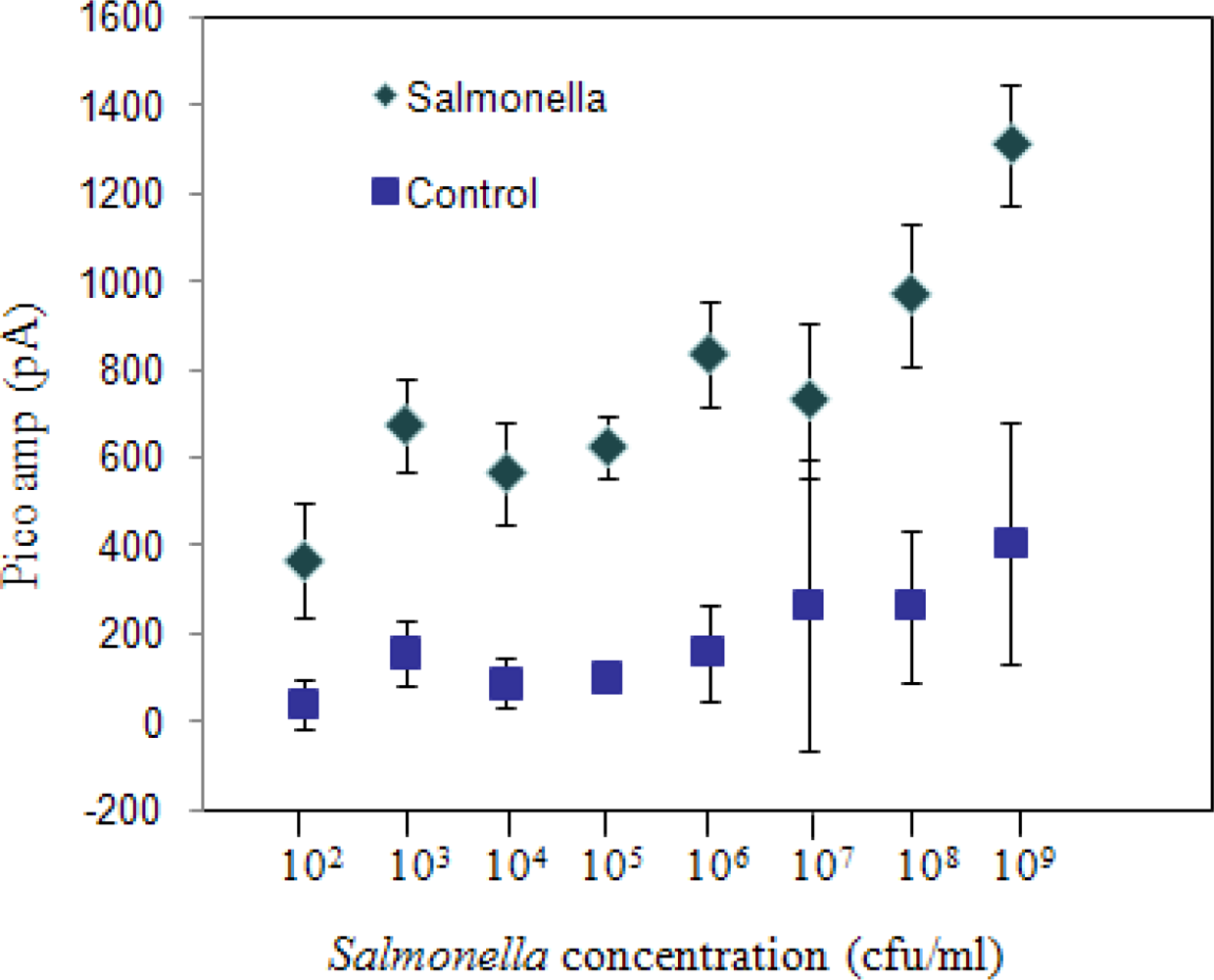
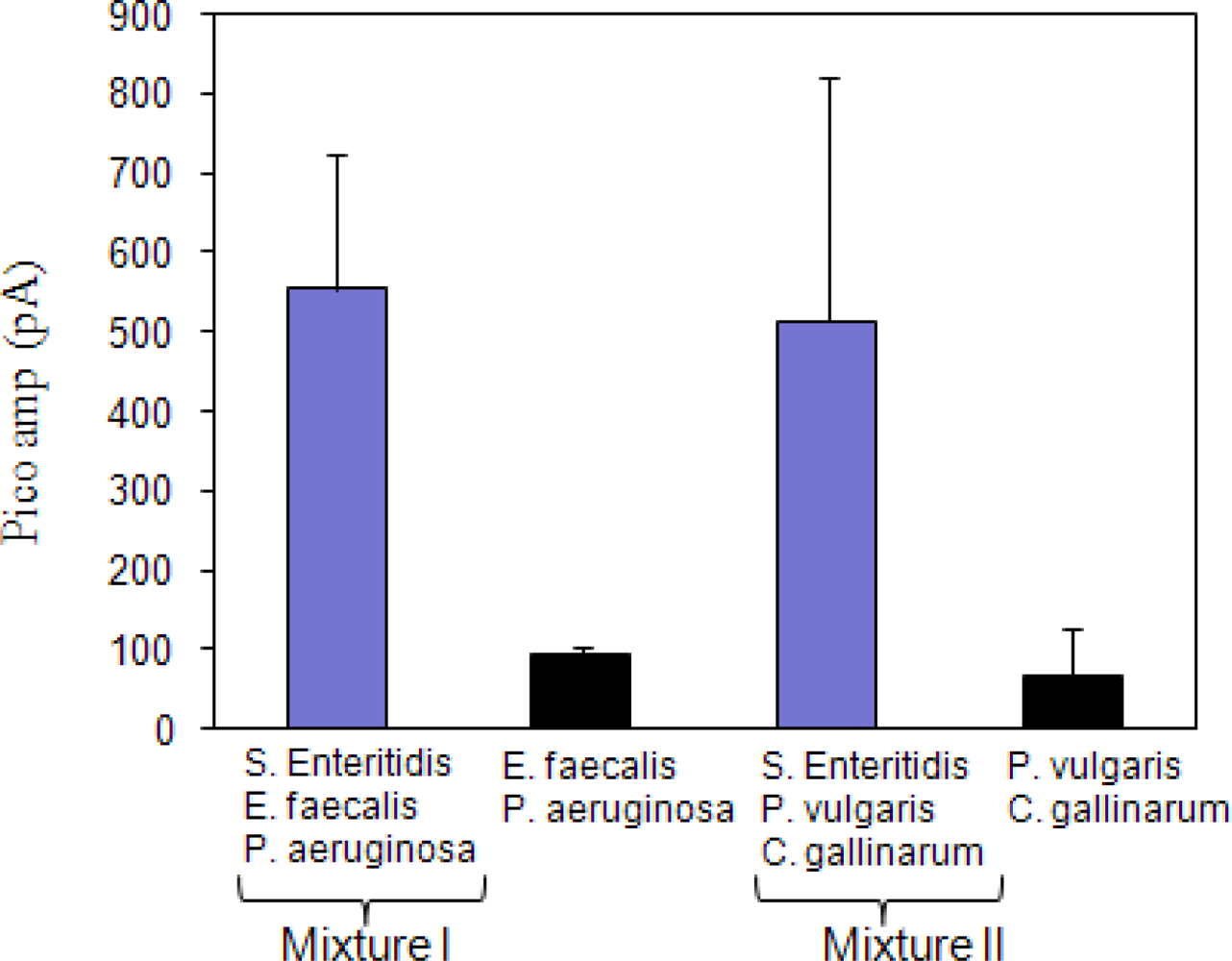
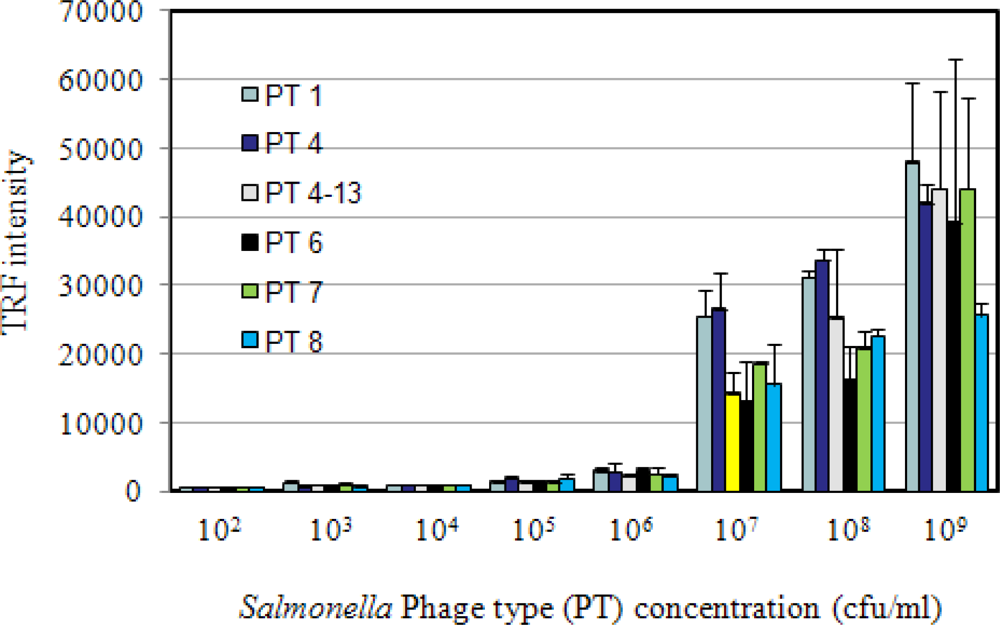
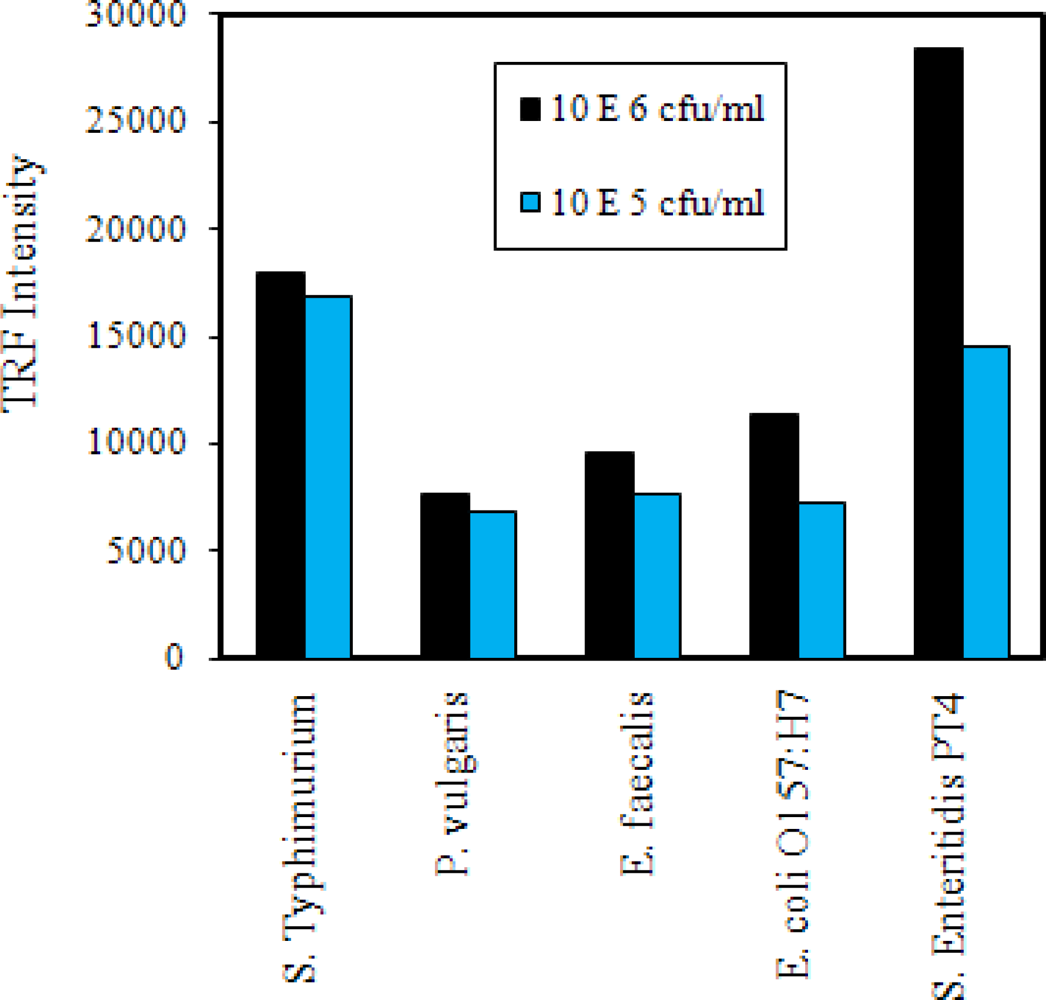
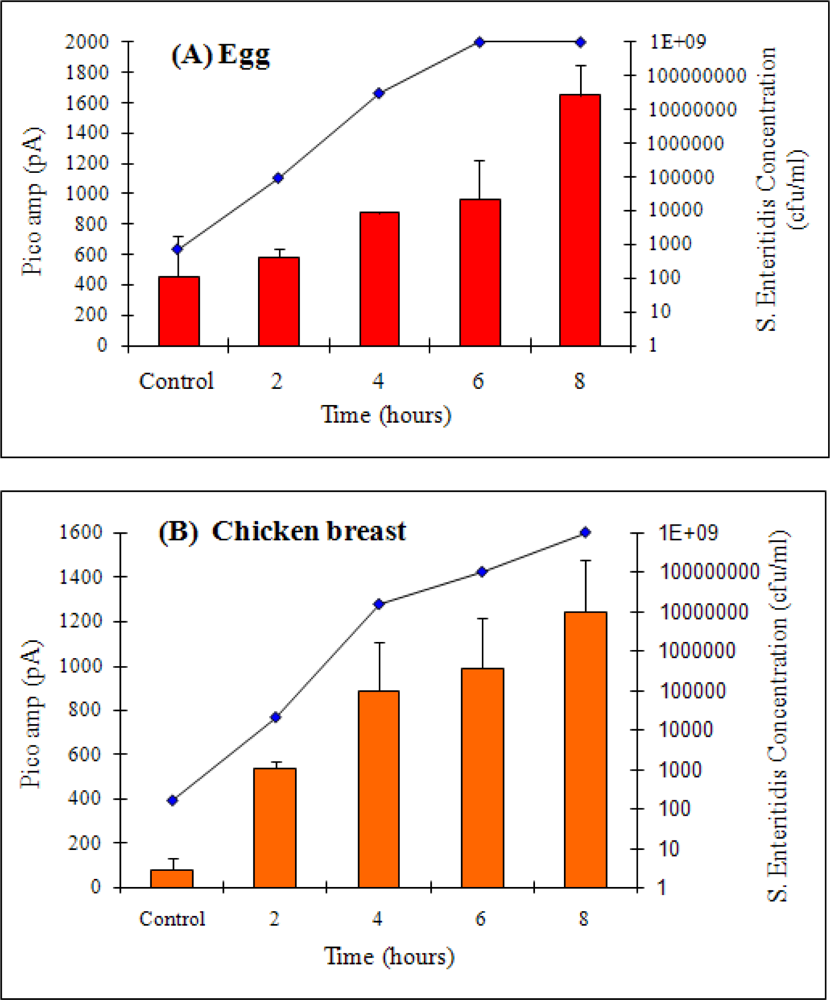
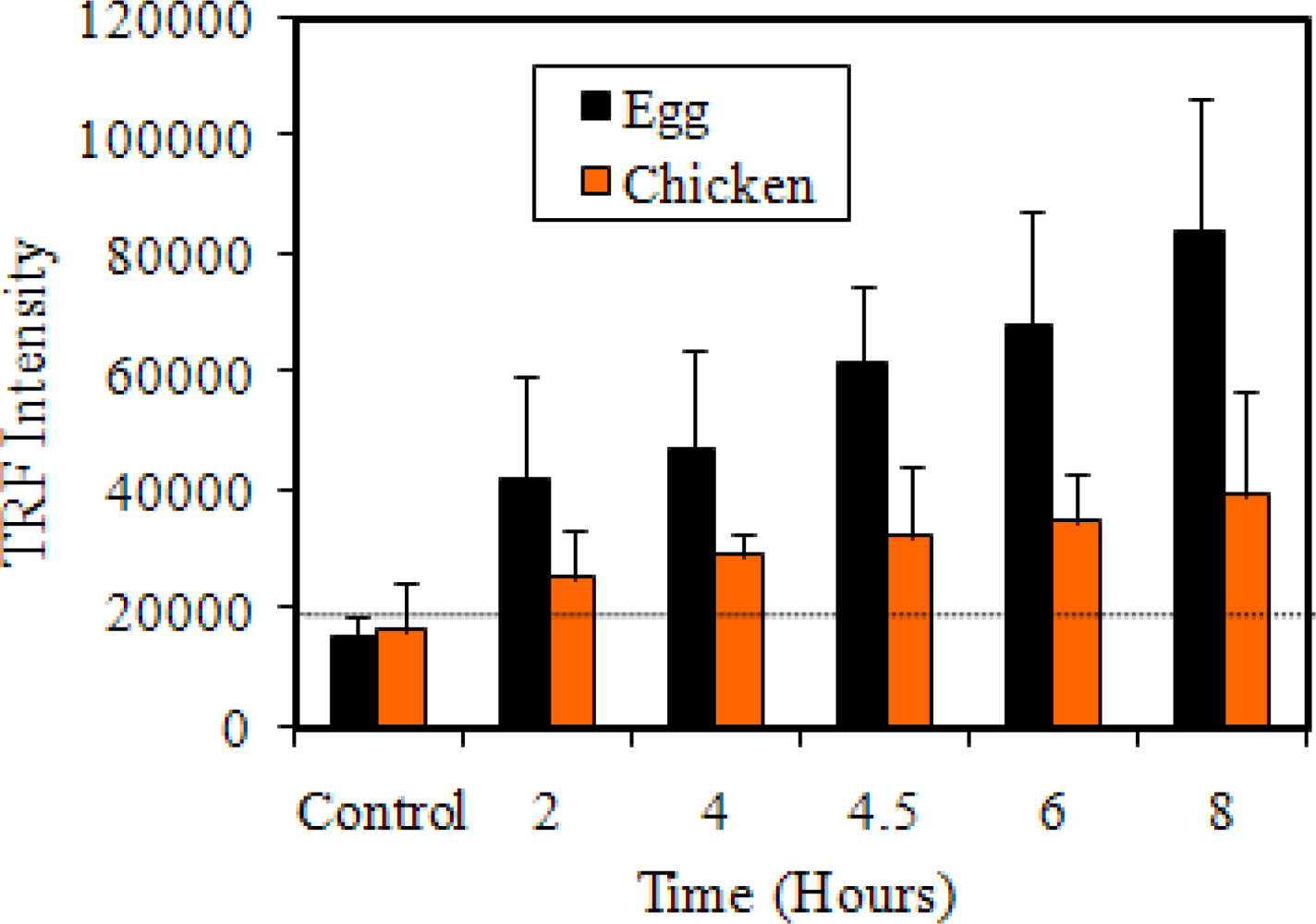
| Bacterial Culture | Avg (pA)a | Control (pA) | Results |
|---|---|---|---|
| Salmonella Enteritidis | 997.97 ± 91.85 | 285.08 | Positive |
| Salmonella Typhimurium | 868.13 ± 31.29 | 299.06 | Positive |
| Escherichia coli O157:H7 | 570.00 ± 227.20 | 207.78 | Negative |
| Staphylococcus aureus | 906.39 ± 74.93 | 262.98 | Positive |
| Enterococcus faecalis | 789.87 ± 168.62 | 453.62 | Negative |
| Lactobacillus rhamnosus | 481.10 ± 166.96 | 311.07 | Negative |
| Listeria monocytogenes | 420.38 ± 95.86 | 270.60 | Negative |
© 2009 by the authors; licensee MDPI, Basel, Switzerland This article is an open access article distributed under the terms and conditions of the Creative Commons Attribution license (http://creativecommons.org/licenses/by/3.0/).
Share and Cite
Valadez, A.M.; Lana, C.A.; Tu, S.-I.; Morgan, M.T.; Bhunia, A.K. Evanescent Wave Fiber Optic Biosensor for Salmonella Detection in Food. Sensors 2009, 9, 5810-5824. https://doi.org/10.3390/s90705810
Valadez AM, Lana CA, Tu S-I, Morgan MT, Bhunia AK. Evanescent Wave Fiber Optic Biosensor for Salmonella Detection in Food. Sensors. 2009; 9(7):5810-5824. https://doi.org/10.3390/s90705810
Chicago/Turabian StyleValadez, Angela M., Carlos A. Lana, Shu-I Tu, Mark T. Morgan, and Arun K. Bhunia. 2009. "Evanescent Wave Fiber Optic Biosensor for Salmonella Detection in Food" Sensors 9, no. 7: 5810-5824. https://doi.org/10.3390/s90705810




